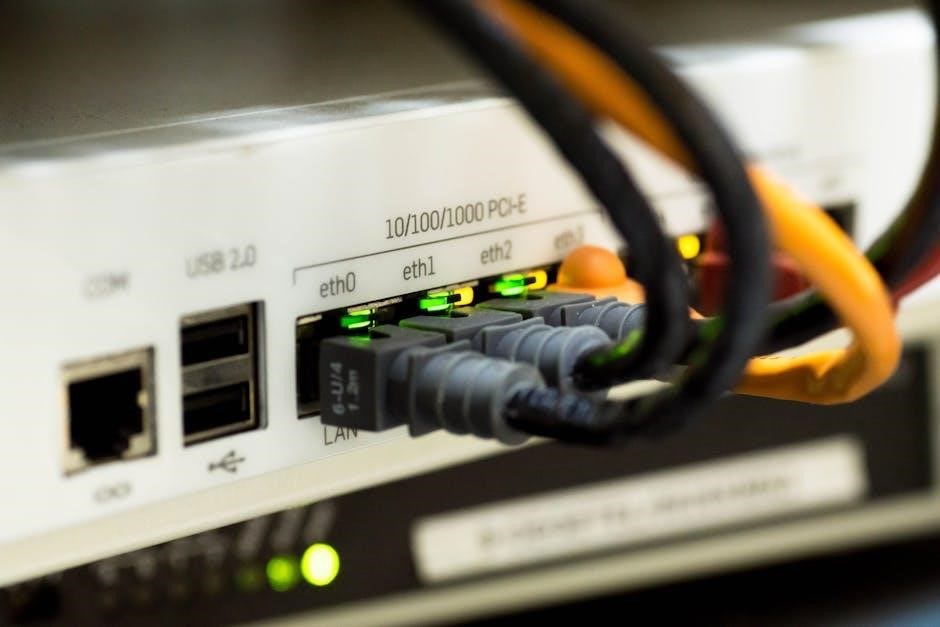
Ethernet cable wiring is a reliable way to establish high-speed‚ secure network connections. It involves using twisted-pair cables with RJ-45 connectors‚ following T568A or T568B standards for proper wiring. Professional installation ensures a stable and efficient network‚ suitable for homes‚ offices‚ and industrial settings.
1.1 Importance of Ethernet Wiring
Ethernet wiring is the backbone of any reliable and high-performance network infrastructure. Unlike wireless connections‚ Ethernet provides a stable and consistent link‚ ensuring minimal latency and maximum data transfer speeds. It is particularly crucial in environments where uninterrupted connectivity is vital‚ such as businesses‚ data centers‚ and smart homes. Ethernet wiring supports advanced applications like video streaming‚ online gaming‚ and IoT devices‚ making it indispensable for modern networking needs. Additionally‚ it offers enhanced security compared to wireless networks‚ as physical connections are harder to breach. Investing in proper Ethernet wiring ensures scalability‚ future-proofing‚ and optimal performance for years to come.
1.2 Benefits of a Hardwired Network
A hardwired network offers unparalleled stability and reliability‚ eliminating interference issues common with wireless connections. It ensures consistent high-speed data transfer‚ making it ideal for demanding applications like video streaming and large file transfers. Enhanced security is another advantage‚ as physical connections are harder to breach than wireless networks. Additionally‚ wired networks are easily scalable‚ accommodating growing infrastructure needs without compromising performance. They also provide cost-effectiveness in the long term‚ requiring less maintenance and offering lower operational costs. These benefits make hardwired networks a preferred choice for businesses‚ schools‚ and data centers where uninterrupted service is critical.
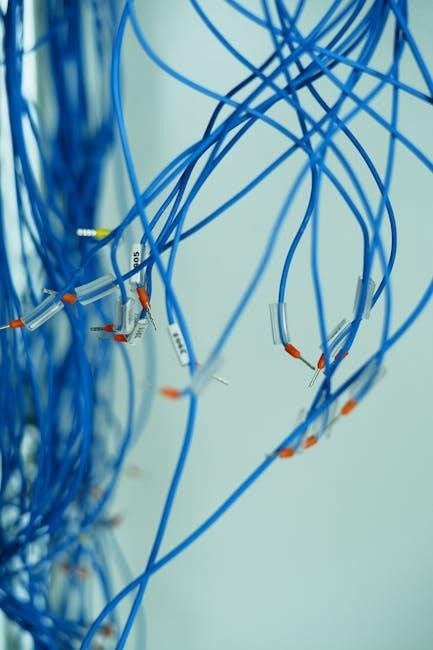
Planning Your Network
Planning your network involves assessing space‚ determining connectivity needs‚ and selecting appropriate cables and hardware to ensure reliable and efficient performance for current and future demands.
2.1 Assessing Your Network Needs
Assessing your network needs involves evaluating the number of devices‚ their types‚ and their locations. Consider the required data speed and whether the network will support high-bandwidth activities like streaming or online backups. Identify the physical layout of your space‚ including walls‚ floors‚ and obstacles‚ to determine cable routing. Determine if existing infrastructure‚ such as Ethernet ports or switches‚ can be reused. Consider future expansion to avoid frequent upgrades. Mapping out the network physically and logically ensures efficient cable placement and minimizes signal interference. This step is crucial for designing a reliable and scalable network that meets both current and future demands.
2.2 Choosing the Right Cable Type
Choosing the right cable type is critical for optimal network performance. Consider factors like data transfer speed‚ distance‚ and environmental conditions. Cat5e cables are suitable for basic networking needs‚ while Cat6‚ Cat6a‚ or Cat7 cables are better for high-speed applications; Shielded (STP/FTP) cables are ideal for environments with electromagnetic interference. Assess the maximum distance between devices to avoid signal degradation‚ as cables longer than 100 meters may require repeaters. Also‚ consider future scalability to ensure your cable choice supports potential upgrades. Selecting the appropriate cable type ensures reliable connectivity‚ minimizes signal loss‚ and meets the specific demands of your network setup. This decision directly impacts performance‚ so it’s essential to align it with your assessed needs.

Understanding Cable Types and Categories
Ethernet cables are categorized by performance‚ with higher categories offering faster speeds and better bandwidth. Cat5e‚ Cat6‚ and Cat7 cables are common‚ each suited for specific network demands.
3.1 Cat5e Cables
Cat5e (Category 5 Enhanced) cables are a popular choice for Ethernet networks‚ offering reliable performance for basic to moderate networking needs. They support speeds up to 1 Gbps (1000 Mbps) and frequencies up to 100 MHz‚ making them suitable for small home networks‚ offices‚ and Internet of Things (IoT) devices. Cat5e cables are cost-effective and widely compatible with older systems‚ though they may not support higher bandwidth demands. They consist of four twisted copper pairs‚ reducing electromagnetic interference (EMI). While newer categories like Cat6 offer better performance‚ Cat5e remains a practical option for applications where faster speeds are not required. Their simplicity and affordability make them a common choice for everyday use.
3.2 Cat6‚ Cat6a‚ and Cat7 Cables
Cat6‚ Cat6a‚ and Cat7 cables are advanced Ethernet cables designed for high-performance networking. Cat6 supports speeds up to 10 Gbps and frequencies up to 250 MHz‚ making it ideal for small businesses and home networks requiring faster connections. Cat6a‚ an enhanced version‚ operates at 500 MHz and supports 10 Gbps over longer distances‚ offering better noise reduction and reliability. Cat7 cables are the most advanced‚ capable of 40 Gbps speeds and 600 MHz frequencies‚ but they are less commonly used due to higher costs. These cables are better suited for enterprise environments or future-proofing installations. Cat6a and Cat7 often include additional shielding‚ such as foil wrapping‚ to minimize interference‚ ensuring superior data transmission quality and reliability in demanding applications.
Cable Shielding Types
Cable shielding types‚ such as UTP‚ STP‚ and FTP‚ reduce electromagnetic interference (EMI) and ensure reliable data transmission in various network environments and conditions.
4.1 UTP (Unshielded Twisted Pair) Cables
UTP (Unshielded Twisted Pair) cables are the most commonly used Ethernet cables due to their cost-effectiveness and ease of installation. They consist of twisted copper pairs without additional shielding‚ making them lightweight and flexible. UTP cables are suitable for indoor networks and are widely used in local area networks (LANs)‚ offices‚ and home networks. They support various Ethernet standards‚ including Cat5e‚ Cat6‚ and Cat6a‚ offering speeds from 100 Mbps to 10 Gbps. While UTP cables are prone to electromagnetic interference (EMI) in noisy environments‚ they remain the preferred choice for most applications due to their simplicity and affordability. Proper installation and routing can minimize potential interference issues.
4.2 STP (Shielded Twisted Pair) and FTP (Foiled Twisted Pair) Cables
STP (Shielded Twisted Pair) and FTP (Foiled Twisted Pair) cables are designed to provide enhanced protection against electromagnetic interference (EMI) and radio-frequency interference (RFI). STP cables feature a braided or foil shield around the twisted pairs‚ while FTP cables use a foil wrapping. These designs make them ideal for industrial or high-noise environments where data integrity is critical. Compared to UTP cables‚ STP and FTP offer better performance in environments with heavy machinery or wireless interference. However‚ they are heavier‚ less flexible‚ and more expensive than UTP cables‚ making them less common in typical office or home networks. Their superior shielding ensures reliable data transmission in challenging conditions.
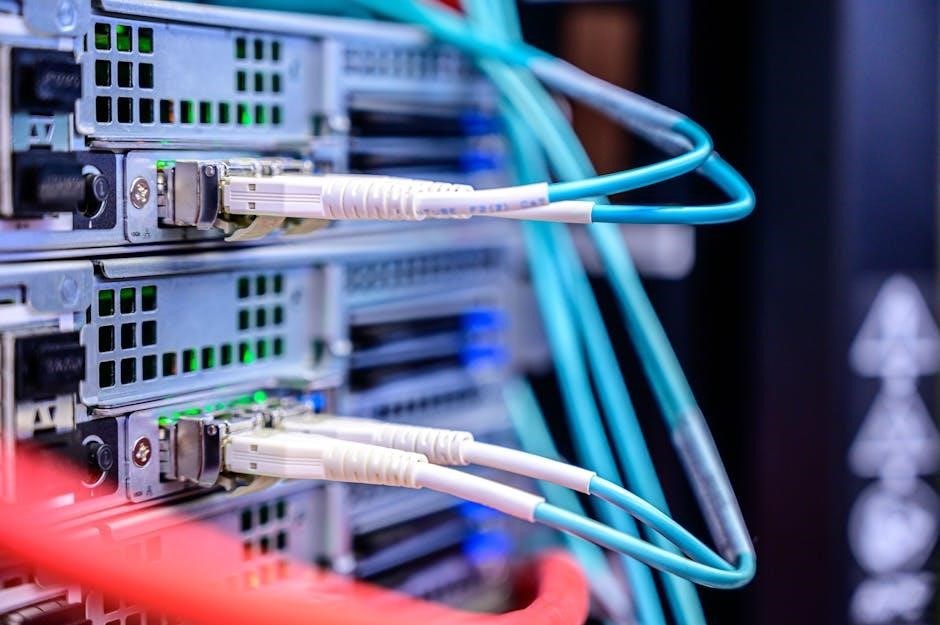
Wiring Standards and Diagrams
This section covers essential wiring standards‚ diagrams‚ and best practices for proper Ethernet cable termination and installation‚ ensuring reliable and high-performance network connections.
5.1 T568A Wiring Standard
The T568A wiring standard is one of the most commonly used methods for terminating Ethernet cables. It specifies the color-coded wiring pattern for connecting twisted-pair cables to network devices. The standard defines the pinout configuration for both ends of a cable‚ ensuring compatibility with devices like routers‚ switches‚ and computers. T568A is part of the TIA/EIA-568 telecommunications standard and is widely adopted for its reliability and performance. It supports various Ethernet speeds‚ including 10BASE-T‚ 100BASE-TX‚ and 1000BASE-T. Proper termination using T568A ensures minimal signal interference and optimal data transmission. This standard is essential for creating straight-through cables‚ which are used for connecting devices to a network infrastructure.
5.2 T568B Wiring Standard
The T568B wiring standard is another widely recognized method for terminating Ethernet cables‚ offering a slightly different wire arrangement compared to T568A. It is also part of the TIA/EIA-568 standard and is compatible with the same range of Ethernet speeds. The primary difference lies in the placement of the orange and green wire pairs. T568B is commonly used in industrial and commercial settings‚ providing reliable connections for network devices. It supports both straight-through and crossover cable configurations‚ depending on the application. While T568A and T568B are interchangeable in most cases‚ consistency across a network is crucial to avoid connectivity issues. T568B is a versatile and dependable choice for Ethernet installations‚ ensuring high-performance data transmission.
5.3 Straight-Through vs. Crossover Cables
Straight-through and crossover cables are two types of Ethernet cables that differ in their wiring configurations. Straight-through cables are the most common and are used to connect devices of different types‚ such as a computer to a router or switch. They follow either the T568A or T568B wiring standard and are suitable for most network setups. Crossover cables‚ on the other hand‚ are used to connect devices of the same type‚ like two computers or two switches. They reverse the transmit and receive pins‚ allowing data to flow correctly between identical devices. While modern network equipment often supports auto-crossover detection‚ understanding the difference remains essential for manual configurations and troubleshooting legacy systems.
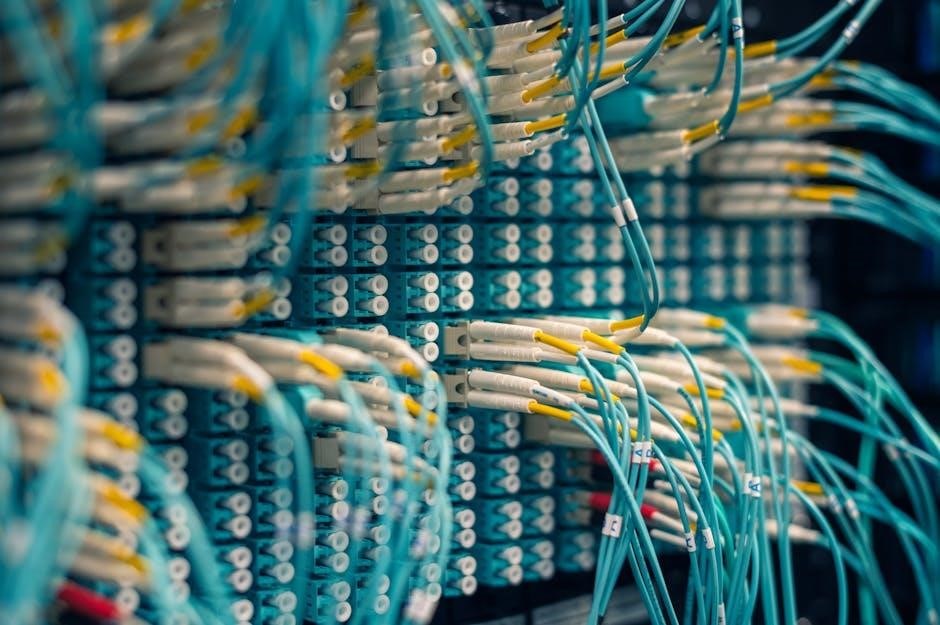
Tools and Materials Needed
Essential tools include a cable tester‚ wire cutters‚ punch-down tool‚ and crimping tool. Materials needed are patch cables‚ connectors‚ and cable ties for organization.
6.1 Essential Tools for Ethernet Wiring
Installing an Ethernet network requires specific tools to ensure proper connections and reliability. A cable tester is crucial for verifying wire continuity and detecting faults. Wire cutters or a cable cutter are needed to trim cables to the correct length. A crimping tool is used to attach RJ-45 connectors securely. For terminating cables in patch panels‚ a punch-down tool is essential. Additionally‚ a cable stripper helps remove the outer jacket and inner insulation efficiently. These tools ensure precise and professional installation‚ minimizing errors and improving network performance.
6.2 Consumables and Accessories
Several consumables and accessories are necessary for a successful Ethernet wiring project. RJ-45 connectors are required for terminating cables‚ while patch panels and wall jacks provide organized network ports. Cable ties and Velcro straps help manage cables neatly. Cable labels and a label maker ensure easy identification of connections. Faceplates and grounding kits are essential for installing wall outlets securely. Additionally‚ Ethernet couplers can extend cable lengths‚ and network adapters may be needed for devices without built-in Ethernet ports. These items ensure a clean‚ functional‚ and scalable network setup‚ preventing signal loss and interference.
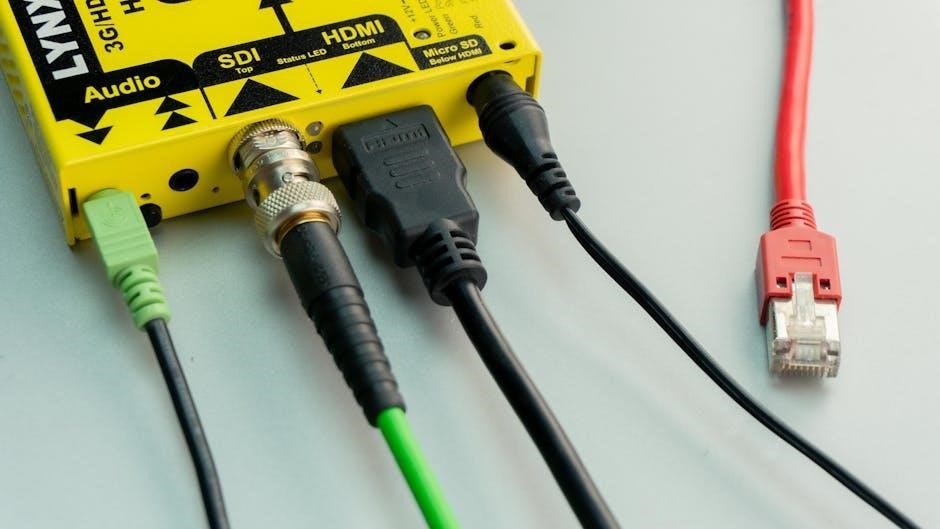
Step-by-Step Installation Guide
A comprehensive guide covering preparation‚ cable running‚ termination‚ and testing phases. Ensures a smooth Ethernet installation process with essential tools and safety tips included.
7.1 Preparing the Work Area
Before starting‚ ensure the workspace is clean and well-lit. Gather all necessary tools‚ such as cable testers‚ wire cutters‚ and patch panels. Organize cables by type and length to avoid tangles. Label each cable clearly for easy identification. Verify the network diagram to confirm connection points. Safety is key—wear protective gear like gloves and ensure no tripping hazards. If working in a busy area‚ use cable management tools to keep wires secure. Double-check that all devices are powered off to prevent damage or electrical shock. Proper preparation ensures efficiency‚ reduces errors‚ and enhances safety during the installation process. A well-organized work area also minimizes downtime and stress.
7.2 Running Cables
Running cables is a critical step in Ethernet wiring. Plan the cable routes carefully to avoid obstacles and ensure minimal interference. Use cable trays‚ clips‚ or staples to secure cables neatly along walls‚ ceilings‚ or floors. For outdoor installations‚ bury cables underground or use UV-resistant jackets. Always follow safety guidelines to prevent damage or electrical hazards. Label cables as you install them for easy identification later. Consider the cable type and its suitability for the environment. Properly securing cables ensures durability and maintains a clean‚ professional appearance. Always test cables after installation to ensure connectivity. This step is crucial for a reliable and efficient network setup. Proper cable management enhances performance and simplifies future maintenance.
7.3 Terminating Cables
Terminating cables is the final step in preparing Ethernet cables for use. It involves attaching RJ-45 connectors to both ends of the cable. Begin by stripping the insulation to expose the inner wires‚ then arrange them according to the chosen wiring standard‚ such as T568A or T568B. Use a crimper to securely attach the connectors‚ ensuring proper alignment to maintain signal integrity. After termination‚ test the cable using a network cable tester to verify all wires are connected correctly. Proper termination is crucial for reliable network performance. Always follow the wiring standard consistently to avoid connection issues. This step ensures your Ethernet cables are ready for installation and provide optimal connectivity.
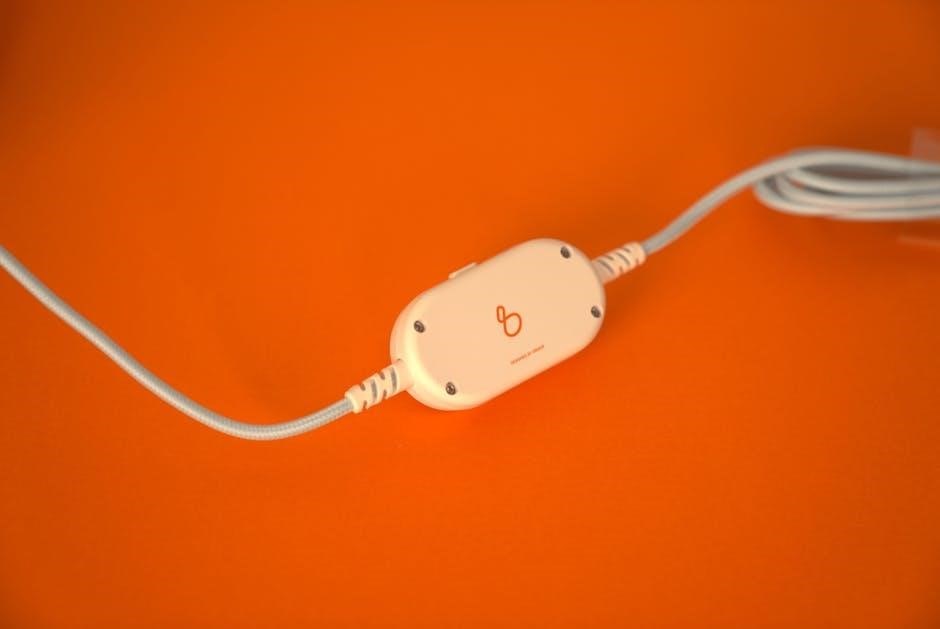
Testing and Troubleshooting
Testing ensures Ethernet cables function correctly‚ while troubleshooting identifies and resolves connectivity issues; Use cable testers to verify wire continuity and signal strength. Check for loose connections‚ damaged cables‚ or incorrect wiring. Resolve issues by inspecting cables‚ tightening connections‚ and replacing faulty components. Regular testing prevents downtime and ensures reliable network performance. Follow wiring diagrams to trace and fix errors efficiently. Proper troubleshooting minimizes delays and maintains optimal connectivity across your network. Always test after installation and troubleshooting to confirm resolution. This ensures your Ethernet setup operates smoothly and meets performance expectations. Detailed testing and systematic troubleshooting are essential for maintaining a stable and efficient network infrastructure.
8.1 Testing Your Ethernet Connections
Testing Ethernet connections is crucial to ensure proper functionality and performance. Begin by using a cable tester to verify wire continuity and identify any open‚ short‚ or crossed connections. Check the link lights on network devices to confirm connectivity. Test for signal strength and data transmission speeds using specialized tools. Inspect cables for physical damage or bent pins that could impair performance. Ensure all connectors are securely plugged in and verify wiring standards like T568A or T568B. Use network diagnostic tools to ping devices and confirm data transfer. Regular testing helps identify issues early‚ ensuring reliable network performance. Always test cables after installation and troubleshooting to confirm resolution and maintain optimal connectivity.
8.2 Common Issues and Solutions
When troubleshooting Ethernet cable wiring‚ common issues include connectivity problems‚ slow speeds‚ or no connection at all. Loose or damaged connections are often the culprit‚ so ensure all plugs are securely inserted. Another issue is incorrect wiring‚ such as reversed or crossed wires‚ which can be resolved by re-terminating the cables correctly. Interference from nearby devices or improper shielding can also degrade performance‚ so consider using shielded cables or moving devices away. If a cable fails testing‚ try swapping it with a known working one. Lastly‚ check for physical damage‚ such as cuts or bends‚ and replace the cable if necessary. Proper testing tools‚ like cable testers‚ can help identify and resolve these issues efficiently.
- Connectivity problems: Check for loose connections or damaged cables.
- Slow speeds: Verify cable category and ensure proper shielding.
- No connection: Test wiring for errors or device configuration issues.
- Signal loss: Improve cable management to prevent bends or damage.

Best Practices for Ethernet Wiring
Proper cable management ensures reliability and efficiency in your network. Always label cables clearly and maintain thorough documentation for easy troubleshooting and future upgrades.
9.1 Cable Management
Proper cable management is essential for maintaining a clean‚ efficient‚ and scalable network infrastructure. This involves organizing cables to prevent tangling‚ reducing signal interference‚ and improving airflow. Use cable ties‚ clips‚ or raceways to secure cables‚ ensuring they are neatly routed along walls or ceilings. Labeling cables at both ends helps identify their purpose and destination. Implementing a color-coding system can further simplify cable identification. Regularly reviewing and updating cable management ensures long-term reliability. Poor cable management can lead to performance issues‚ safety hazards‚ and difficulties in troubleshooting. By prioritizing organization‚ you create a more durable and adaptable network environment.
9.2 Labeling and Documentation
Proper labeling and documentation are crucial for maintaining a well-organized and efficient Ethernet network. Labels on cables‚ ports‚ and connectors ensure clarity‚ making it easier to identify connections and troubleshoot issues. Use a consistent labeling system‚ including cable numbers‚ port names‚ or purpose-based identifiers. Documenting your network includes creating a diagram of cable runs‚ switch configurations‚ and IP address assignments. This documentation serves as a guide for future upgrades‚ repairs‚ and expansions. Invest in a label maker for professional results and store digital copies of your network map for easy access. Regular updates to documentation ensure accuracy and prevent confusion as your network evolves.
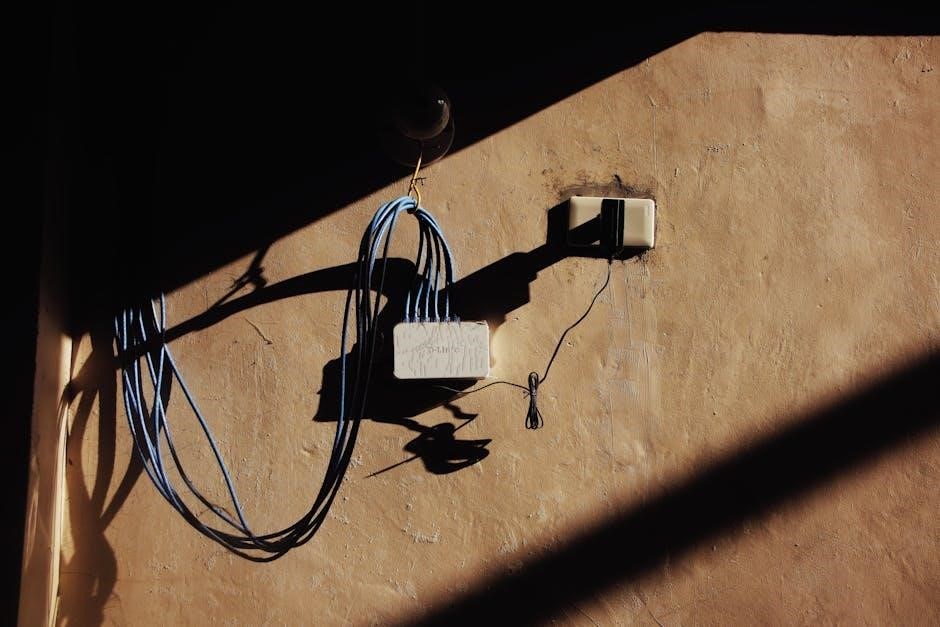
Safety Tips and Precautions
Always handle cables with care to avoid cuts or electrical hazards. Use proper tools to prevent damage or exposure of live wires. Keep work areas clean and well-lit to minimize tripping risks. Avoid overstretching cables‚ as this can cause internal damage. Ensure all connections are secure to prevent loose wires. Never work near open flames or water sources. Wear protective gloves when handling sharp objects or cables. Regularly inspect tools and cables for wear or damage. Follow local electrical safety guidelines to ensure compliance and safety.
- Avoid overbending cables to prevent signal degradation.
- Keep cables away from high-temperature sources.
- Use cable ties or organizers to reduce tripping hazards.
- Disconnect power before performing any maintenance.
10.1 Handling Cables Safely
Handling Ethernet cables safely is crucial to prevent damage and ensure reliability. Always avoid over-bending or twisting cables‚ as this can cause internal wire damage. Use cable ties or clips to manage cables without tightening them excessively. When unwinding cables‚ avoid pulling them forcefully‚ as this can stretch or break the wires. Use a cable tester to check for continuity before installing or connecting live networks. Keep the work area clean and well-lit to minimize tripping hazards. Store cables in a dry‚ cool place‚ away from direct sunlight or moisture. Proper handling ensures longevity and performance of your Ethernet cables.
- Avoid excessive bending or twisting.
- Use appropriate tools for cable management.
- Store cables in a dry‚ protected environment.
10.2 Avoiding Common Mistakes
When wiring Ethernet cables‚ several common mistakes can lead to connectivity issues or degraded performance. One of the most frequent errors is over-tightening connectors‚ which can damage the cable’s internal wiring. Another mistake is improper cable management‚ such as leaving cables loose or unsecured‚ which can cause damage or signal interference. Additionally‚ using the wrong cable category for the intended application can result in poor performance or incompatibility with devices. Incorrect termination techniques‚ such as not following the T568A or T568B wiring standards‚ can prevent the cable from functioning properly. Always test cables after installation to ensure they are working as expected. By being mindful of these pitfalls‚ you can ensure a reliable and efficient network setup.

Future-Proofing Your Network
Ensure your network adapts to future demands by installing higher-category cables like Cat6 or Cat7‚ supporting faster speeds and emerging technologies. Plan for scalability by anticipating device growth and bandwidth needs. Regularly assess and upgrade infrastructure to maintain performance and reliability.
- Install cables that support higher bandwidths.
- Plan for potential increases in devices or users.
- Leave extra cable slack for future upgrades.
- Regularly assess and adapt to new technologies.
11.1 Upgrading Your Infrastructure
Upgrading your network infrastructure is crucial to maintain performance and adapt to evolving technology. Consider replacing older cables with higher-category ones‚ such as Cat6a or Cat7‚ to support faster speeds and reduce interference; Ensure your switches‚ routers‚ and network devices are compatible with newer standards like 10-Gigabit Ethernet or Wi-Fi 6. Regularly assess your network’s bandwidth requirements and plan for scalability. Installing fiber-optic cables for backbone connections can future-proof your setup‚ especially in large or growing networks. Always test upgraded components to ensure seamless integration and optimal performance; By staying ahead with modern hardware and cabling‚ you can avoid bottlenecks and prepare for future technological advancements.
11.2 Planning for Scalability
Planning for scalability ensures your Ethernet network can adapt to future demands without major overhauls. Start by installing higher-category cables than your current needs‚ such as Cat6a or Cat7‚ to support faster speeds and future technologies. Consider the physical layout of your network‚ ensuring pathways for cables are accessible and expandable. Use modular components like patch panels and switches to simplify upgrades. Additionally‚ leave extra cables during installation to accommodate new devices or users. Proper labeling and documentation will help manage growth and minimize downtime during expansions. By prioritizing flexibility and modularity‚ you create a network that evolves seamlessly with your needs‚ avoiding costly bottlenecks and ensuring long-term reliability.

